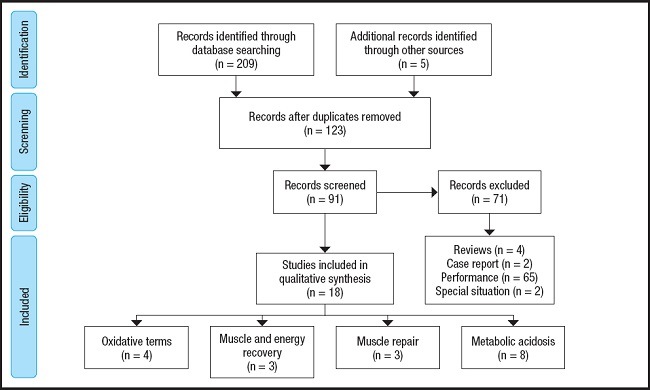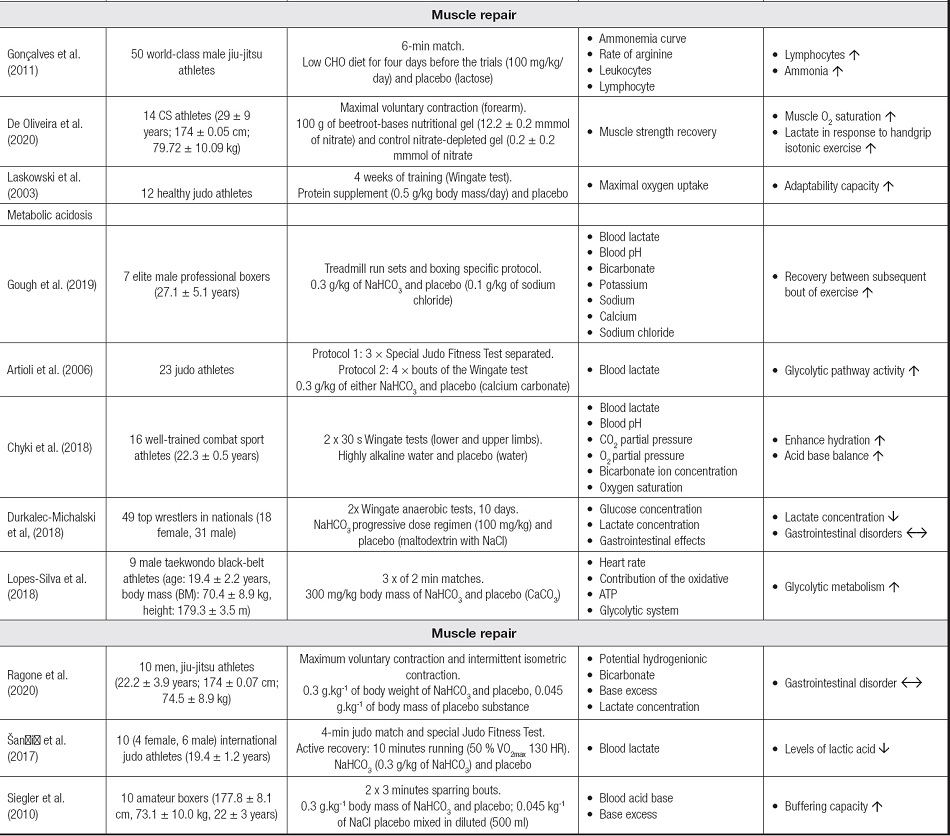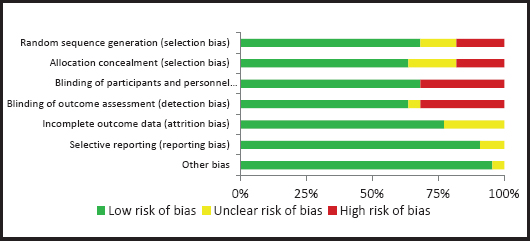INTRODUCTION
Combat sports (CS) are old traditional sports that have been solidly established worldwide. Boxing, mixed martial arts, wrestling, judo, taekwondo, kickboxing, karate, and jiu-jitsu are the main disciplines that have been researched (1). In order to maintain a highly competitive level in these disciplines, the development of diverse performance factors such as aerobic and anaerobic capacities, and an optimal level of power and strength are required (2). Although it is true that performance improvement through physical condition, and technical and tactical training are key in CS, some aspects such as the biomechanical aspects, pharmacological methods, nutritional ingredients, psychological techniques, and different recovery tools must be considered in the complex road to success (3).
Recovery is regarded as a multifactorial process that can be enhanced by different intervention strategies (4). Among them, nutritional aids are considered an important option within this restorative process (5). In fact, ergo-nutritional aids are considered a nutritional ingredient or practice that could improve exercise performance capacity and training adaptations, or enhance recovery from an exercise bout or competition (6). The specific metabolic requirements within the discipline are an important aspect to be considered as they determine the preferred nutritional aid. CS are characterized by a great number of high-intensity movements and short breaks that are insufficient for a complete recovery during the different rounds that compose said bouts (7). This high intensity that is typical of CS disciplines markedly increases acute metabolic and oxidative stress, and much in the same way also produces muscle damage and increased physiological stress. This situation will produce energetic substrate deficiencies and a need to buffer the intracellular H+ generated by exertion. Accordingly, the capacity to recover not only between efforts but also between fights remains crucial to adequately perform in these sport disciplines (8).
According to the American College of Sport Medicine, Academy of Nutrition and Dietetics and Dietitians of Canada, adequate and well-chosen nutritional strategies are necessary for optimal performance across different scenarios in competitive sports (9,10).
Over the last 5 decades sport nutrition has been rapidly evolving and several ergo-nutritional aids have been researched for different purposes; before competition (e.g., pre-exercise fueling), during competition (e.g., fluid intake and carbohydrate feeding), and in the recovery from competition or post-competition (e.g., carbohydrate or protein feeding to promote muscle recovery) (11). However, the cost/benefit ratio of an ergo-nutritional plan must be weighed before application (4).
The current scientific literature has proposed several ergo-nutritional options to be used by CS practitioners: antioxidants, creatine, alkaline water, carbohydrates and proteins, β-alanine or β-hydroxy-β-methylbutyrate, among others. Although some of these ergo-nutritional aids could promote recovery, to the best of the authors' knowledge there is a lack of scientific bibliography, and some controversy exists regarding the results related to the real recovery effect in CS (3). Given the relevance of ergo-nutritional strategies in CS, this systematic review aimed to review the scientific literature to examine which ergo-nutritional methods are the most frequently used by CS athletes, and to determine the appropriate dosage for each one.
MATERIALS AND METHODS
LITERATURE SEARCH STRATEGIES
This systematic review focused on different ergo-nutritional strategies used in CS as well as on their most effective dose and timing of administration. It was carried out following the Preferred Reporting Items for Systematic Review (PRISMA) guidelines (12). A structured search was performed in different sources of high-quality information in the field of health sciences using the following information databases: Medline (PubMed), Web of Science (WOS), the Cochrane Collaboration Database, Cochrane Library, Evidence Database (PEDro), Evidence Based Medicine (EBM) Search review, National Guidelines, EM-BASE, Scopus, and Google Scholar system. This allowed to guarantee a complete bibliographic support and enabled us to identify all relevant studies on this topic. The search strategy ended on April 30, 2021. Search terms included a mix of medical subject headings (MeSH) and free-text words for key concepts related to ergo-nutrition in CS. The keywords used in the next equation of the search were: “combat sports,” “recovery,” “nutrition” “fatigue,” and “ergogenic aids”. The following specific search strategy was applied: antioxidants [MeSH Terms] OR “antioxidants”[All Fields]) AND combat sports [MeSH Terms] OR “combat sports”[All Fields]) AND caffeine [MeSH Terms] OR “caffeine”[All Fields]) AND combat sports [MeSH Terms] OR “combat sports”[All Fields]) AND creatine supplementation [MeSH Terms] OR “creatine supplementation”[All Fields]) AND combat sports [MeSH Terms] OR “combat sports”[All Fields]) AND carbohydrates supplementation [MeSH Terms] OR “carbohydrates supplementation “[All Fields]) AND combat sports [MeSH Terms] OR “combat sports”[All Fields]) AND protein supplementation [MeSH Terms] OR “protein supplementation “[All Fields]) AND combat sports [MeSH Terms] OR “combat sports”[All Fields]) AND alkaline water AND bicarbonate [MeSH Terms] OR “alkaline water AND bicarbonate”[All Fields]) AND combat sports [MeSH Terms] OR “combat sports”[All Fields]) AND beta alanine [MeSH Terms] OR “beta alanine”[All Fields]) AND combat sports [MeSH Terms] OR “combat sports”[All Fields]) AND beta hydroxy beta methylbutyrate [MeSH Terms] OR “ beta hydroxy beta methylbutyrate “[All Fields]) AND combat sports [MeSH Terms] OR “combat sports”[All Fields]). Through this equation relevant articles related to the use of ergogenic aids in CS were obtained. No filters were used to increase the power of the analysis in relation to the athletes' level and age. The specific filters “performance enhancement” and “rapid weight loss” were applied to not determine the recovery effect.
INCLUSION AND EXCLUSION CRITERIA
The search strategy was determined using the PICOS model to define inclusion and exclusion criteria that were relevant to this review (13). P (population): “CS athletes”, I (intervention): “ergo-nutritional supplementation”, C (comparison): “ergo-nutritional supplementation group, different ergo-nutritional strategies versus placebo group or ergo nutritional supplementation in the same group comparing baseline versus post-intervention”, O (outcome): “acute post-exercise response or evolution after ergo-nutritional strategies with recovery effect”, and S (study design): “single, double-blind or randomized design”.
In this systematic review the studies included had to respond to all of the following criteria: (i) participants were men and women and elite or amateur fighters from the following disciplines: boxing, mixed martial arts, wrestling, judo, taekwondo, kickboxing, karate and jiu-jitsu; (ii) participants used some form of ergo nutritional supplementations according to the classification of the Australian Institute (14); (iii) the effects of ergo nutritional aids were compared to an identical experimental situation such as the ingestion of placebo, to a different nutritional protocol in the same CS training group or in the same CS group, to the same nutritional protocol comparing baseline and final outcomes; (iv) articles examined the recovery effects of supplementation; (v) study designs were randomized, double-blind, and placebo-controlled or same group pre and post comparisons. The exclusion criteria included the following: (i) studies that were performed for clinical purposes or therapeutic use; (ii) studies related to performance enhancement; (iii) studies carried out in rapid weight loss moments or 48h before the fight and (iv) other CS that were not considered in this review.
Once the inclusion criteria and exclusion criteria were applied to each study, the data concerning the study source (including the authors and the year of publication), the study design, the administration of the supplement (dose and time), the sample size, and the characteristics of the participants (level, race and sex) were extracted independently by two authors (IL-L and AV) using a spreadsheet (Microsoft Inc, Seattle, WA, USA). Subsequently, disagreements were resolved by discussion until a consensus or third-party adjudication (DM) was reached.
STUDY SELECTION
Two authors identified papers through database searching (IL-L and AV). Only original articles written in English and published in peer-reviewed journals were considered for inclusion in this systematic review. Accordingly, abstracts, non-peer-reviewed papers and book chapters were excluded. Titles and abstracts of scientific publications identified by the search strategy were screened for a subsequent full-text review and were cross-referenced to identify duplicates. Moreover, the references sections of all relevant articles were also examined applying the snowball strategy (15). All trials assessed for eligibility and classified as relevant were retrieved, and their full text was peer-reviewed (IL-L and AV). Based on the information of the full-text reports, inclusion and exclusion criteria were used to select the trials eligible for inclusion in this systematic review. Disagreements were resolved through discussions among 3 authors (IL-L, AV and DM).
DATA EXTRACTION
Once inclusion and exclusion criteria were applied, study data were extracted independently by 2 authors (IL-L and AV). The following data were extracted from each paper: study source (author/s and year of publication); sample (level of activity or sports discipline, age, gender and number of participants); intervention (type of ergo nutritional supplementation, administration protocol, source from which it was obtained) and physiological outcomes that were measured.
RISK OF BIAS ASSESSMENT
Trials with unclear or inadequate methodological quality may be associated with risk of bias when compared to trials using adequate methodology (16). This bias may lead to either an overestimation or underestimation of the true effect, so it is imperative to carefully consider the potential limitations of the included studies in order to obtain reliable conclusions. Following the Cochrane Handbook for Systematic Reviews of Interventions (17), two authors (IL-L and AV) independently assessed the risk of bias in the included studies using the assessment criteria defined in the protocol. Eventual differences in the risk of bias of trials were resolved by discussion with a third-party evaluator (DM) in order to reach consensus. In the Cochrane Risk of Bias tool, the following sources of bias were included and divided into different domains, defined as: 1) selection bias (items: random sequence generation, allocation concealment), 2) performance bias (blinding of participants and personnel), 3) detection bias (blinding of outcome assessment), 4) attrition bias (incomplete outcome data), 5) reporting bias (selective reporting), and 6) other bias (other sources of bias). The assessment of the risk of bias was characterized as low risk (plausible bias unlikely to seriously alter the results), unclear risk (plausible bias that raises some doubts about the results), or high risk (plausible bias that seriously weakens confidence in the results).
RESULTS
SEARCH STRATEGY
The literature search provided a total of 209 articles related to the selected descriptors. Also, 5 that were not found initially for full-text analysis were included for relevance. A total of 214 were certificated through database search and other sources. After removing duplicates, 91 studies were screened. After the application of eligibility criteria 73 were excluded as they were related only to performance capacity or rapid weight loss moments. Eighteen met all the inclusion/exclusion criteria and showed a real recovery effect in their conclusions. All of them were also suggested by the third researcher. Consequently, 18 studies met the previously defined inclusion criteria and were included in the systematic review (Fig. 1)
SAMPLE CHARACTERISTICS
Sample characteristics are shown in table I. The total sample consisted of 367 participants (n = 336 males; n = 31 females) (18-35). All studies were performed using adult populations except 3 of them in which part of the sample was composed by underage participants (20-28,31). In relation to the CS disciplines, 6 studies were about judo (19,22,24,26,32,34), 3 about taekwondo (18-21,28), 2 about jiu-jitsu (27-30), 3 about wrestling (20-23,31), 2 about boxing (29,35), and in 2 of them the sample was described as CS athletes (25-33). As regards the sample's level, 5 studied world-class or Olympic athletes (18,27,32,34,35), 3 studied elite or national-level athletes (19-28,31), 2 studied trained or well-trained athletes (23,33), 2 studied amateur and university level athletes (21-29), and finally 5 studies described the sample without specifying performance level (20,22,24-26,30).
Table I. Summary of the studies that investigated the effects of different ergo-nutritional strategies and are included in the systematic review
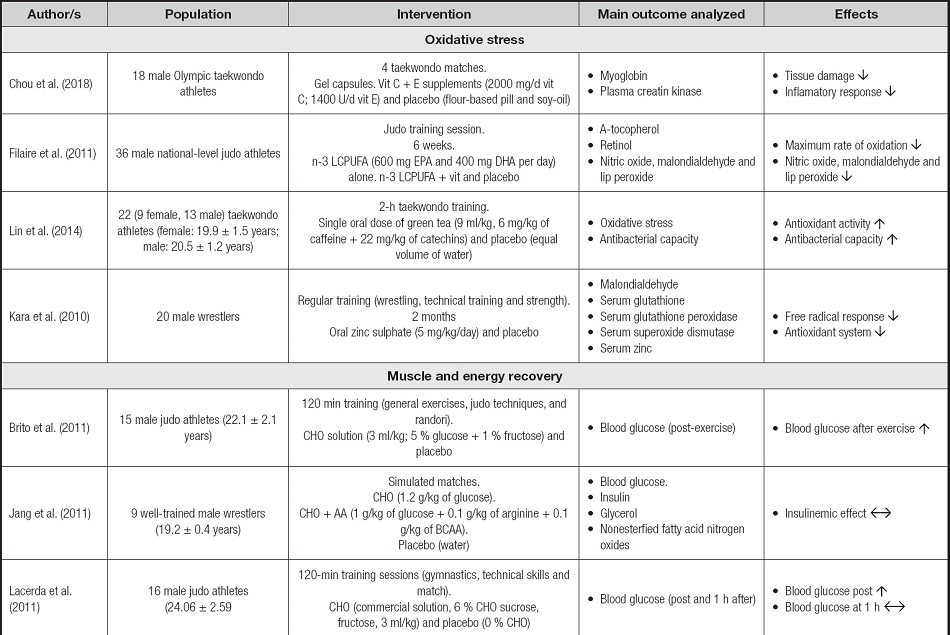
ERGO-NUTRITIONAL STRATEGIES
The sources about the recovery effect in the CS field were varied, and all of them were grouped into 4 general effects (Table I); i) vitamins and minerals for health maintenance and stress delaying effects (18-20,21); ii) carbohydrates for energy contribution and glycogen replenishment; iii) protein for muscle repair, homeostasis maintenance and effective supercompensation (26,27); and iv) ergogenic aids for the maintenance of an optimal state of metabolic alkalosis (28-31,34,35).
RISK OF BIAS
Details for all sources of bias, divided into different domains, are presented in figure II and figure III.
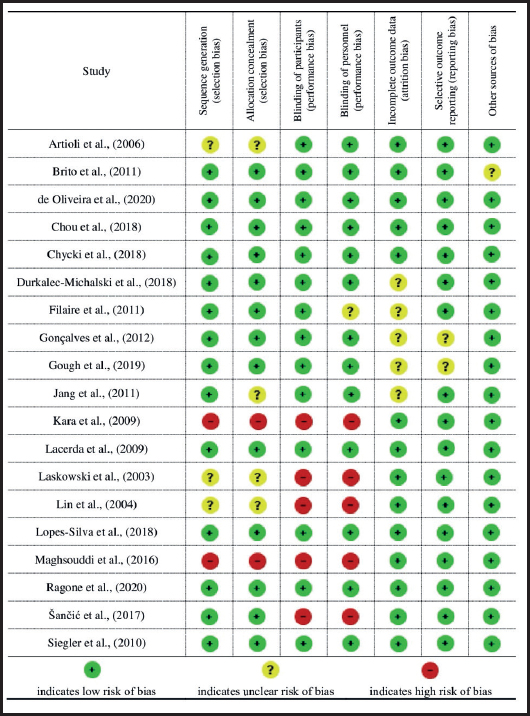
Figure 2. Risk of bias graph: review of author judgments about each risk of bias item for each included study
DISCUSSION
In order to minimize the risk of injury and to enhance the recovery process, nutritional strategies could be effective to enhance the recovery rates that are necessary during multiple competing periods characterized by several practices per day (4). CS fighters and performance staff must be knowledgeable, and they should be able to choose the best nutritional strategy for each process involved in CS competition or training (36). Despite the variety of disciplines that compose CS and the different studies that have analyzed the effect of ergo-nutritional strategies on recovery enhancement, to the best of the authors' knowledge there have been no reviews related to the status of the different ergo-nutritional strategies as recovery tools.
OXIDATIVE STRESS
The metabolic and mechanical stress imposed by CS generates inflammation and oxidative stress. This situation occurs when athletes do not possess an adequate capacity to protect their bodies against free radicals (36). During competition and training, when repeated bouts with short recovery breaks are needed, the main concern is performing at maximum capacity (8). Efficiency in recovery periods can be beneficial in attenuating muscle damage and post-exercise inflammatory responses (37). Vitamin and mineral support is needed for health maintenance and stress management. In a recent study, it was determined that up to 90 % of athletes had vitamin deficiencies (38). Some groups of vitamins are primary regulators of metabolic functions and are considered as real antioxidants. For example, vitamin C can directly quench free radicals, recycle vitamin E to suppress oxidative damage, and reduce eccentric exercise-induced muscle soreness and damage (39). On the other hand, vitamin E protects against oxidative stress and muscle damage after high-intensity exercise (40). In the sports field, recent studies in endurance specialties have shown better physiological adaptations obtained after intensive (41) rather than light training (42).
To date, only two studies have tried to show the recovery effects of vitamins in the CS field. Chou-Chung et al. observed the effects of short-term high-dose vitamin C plus E supplementation after intensive training and competition by comparing supplementation and placebo groups. Nine athletes in each group were analyzed for different parameters of inflammatory response and muscle damage. The results showed that 4 days with short-term vitamin C and E supplementation attenuate the damage and inflammatory responses that occur during and after successive taekwondo matches (18). Also, in order to observe the combined effects of different vitamins, Filaire et al. described the influence of 6 weeks of fatty acid supplementation with vitamin E and C in judo athletes, and determined that the consumption of an n-3 LCPUFA fatty acid combined with vitamin E plus C increased oxidative capacity after a judo training season (19). It should be noted that there were other researchers that studied vitamins in CS, but their results were inconclusive and directly related to performance rather than recovery (43-45). Also, some scientific articles tried to understand the antioxidant effects of vitamins. However, they were rejected in the current review because they did not meet the criteria related to study design (46,47).
Some evidence points towards the protective effect of different minerals on free-radical formation and oxidative stress, but only one study analyzed this response in CS. Kara et al. examined the effect of zinc supplementation on free-radical formation and the antioxidant system in a wrestling group, and determined that zinc sulfate (5 mg/kg/day) administered to athletes contributes to their health and performance by preventing the production of radicals while activating the antioxidant system (20).
Regarding natural supplementation, inflammation, and oxidative stress, the scientific literature is very scarce. Only green tea could be highlighted as a recovery enhancer in the CS field. Lin et al. investigated the short-term effect of green tea consumption in taekwondo athletes following intensive training, and showed that this infusion significantly enhances oxidative activity and some immune-system proteins (21). Natural supplements could produce an increase in the activity of the oxidative system (forearm SmO2 and amylase); so, despite the scarce scientific evidence available, they should be further explored.
MUSCLE AND ENERGY RECOVERY
Scientific evidence determines that carbohydrates (CHO) are the main energy source that allows replenishment of muscle glycogen stores. Given that a deficit of this substrate could anticipate early fatigue and consequently decreased performance in CS disciplines, an adequate nutritional plan can assist in the maintenance of performance and delay the onset of fatigue (22,48).
CS athletes are advised to consume an adequate CHO intake before a competitive bout, and supplementation with 8-10 g of CHO/kg of body mass per day is typically suggested in these disciplines. In relation to the recovery process, the intake of CHO solutions could be an effective strategy (49). On the one hand, to maintain blood glucose levels and delay fatigue, and on the other hand to diminish the alterations of the immune system that are typical of high intensity exercise and very hot environments (50). Those results were reported by Brito et al. in 15 male judo athletes after an intake of 3 mL (CHO)/kg for each 20 minutes of practice (22). This same protocol was tested by Lacerda et al. in a group of 16 CS athletes, and the same results were obtained. CHO supplementation during a judo training session (3 mL (CHO)/kg every 20 minutes) generated less disturbance in total leukocytes and could protect the immunological health of atheletes (24).
Regarding the combinations of CHO with other macronutrients, it should be noted the only one study tried to examine whether post-exercise CHO supplementation could restore performance in subsequent simulated wrestling matches. Jang et al. analyzed the effect of CHO or CHO plus branched-chain amino acids and arginine on glucose in a group of well-trained wrestlers. At the end of the fights (3 fights analyzed; 3 minutes and 1-minute rests) 3 different supplementations were consumed: 1.2 g/kg of glucose, 1 g/kg of glucose + 0.1 g/kg of arginine + 0.1 g/kg of amino acids or water (placebo trial). The results were inconclusive and determined that CHO supplementation with or without amino acids and arginine during the post-fight period had no effect on recovery in the following simulated fights in wrestlers (23). Due to the lack of studies in CS, the following guidelines could be promoted to enhance post-exercise recovery: a minimum of 8-10 g of CHO/kg and between 1.4 g/kg to 2.0 g/kg of PR per day (51). However, more research is necessary in order to establish the most appropriate doses.
MUSCLE REPAIR
To date, only three studies have evaluated muscle damage and the adaptive response after ergo-nutritional supplementation in the CS field. Two of them evaluated protein (PR) supplementation, and only one analyzed natural supplementation with beetroot gel (25-27). Regarding high performance disciplines, protein (PR) is required to maintain high levels of training and good performance. An optimal dietary PR intake provides a foundational aspect for promoting recovery (49). The role of PR on recovery includes a positive effect on muscle protein synthesis, lean tissue gains, and reductions in the signs and symptoms of exercise-induced muscle damage (52). No previous scientific evidence has been found to determine unique criteria around PR, CS, and recovery, so according to the recommendations of the International Society of Sports Nutrition in relation to daily PR intake for CS, a range of 1.4 g/kg to 2.0 g/kg per day is considered the most appropriate dose to guarantee adequate recovery after training or competition.
Only two nonspecific studies showed the possible increase of post-effort adaptation after protein supplementation (26,27). Laskowsky and Antosiewicz observed this adaptive effect on twelve judoists after administering 0.5 g/kg body mass/day protein supplementation before and after 4 weeks of highly intensive training (26). They observed the metabolic stress as hyperammonemia after high-intensity exercise. In this study, 100 mg/kg of arginine reduced lymphocytes and ammonia. This change in ammonia metabolism could be related to better recovery and adaptations after high-intensive training (27). The use of beetroot gel could also be remarked as a recovery enhancement in CS. De Oliveira et al. tried to assess the effect of beetroot gel on exercise time until fatigue in response to handgrip isotonic exercises. Although this is an analytic exercise, their results determined that a single dose of beetroot gel supplementation may be considered a good nutritional strategy to accelerate strength recovery in CS athletes (25). More studies are needed in order to establish the most appropriate dose that minimizes muscle damage and enhances adaptation responses in the CS field.
METABOLIC ACIDOSIS
For optimal performance in CS, the anaerobic glycolytic pathway must be optimized due to the need to buffer the intracellular H+ that is produced during the high-intensity intermittent efforts that are common in these sport disciplines. These intervals are intercalated with phases of lower intensity and partial recoveries between the rounds that normally compose a fight (28). This metabolic response seems to be necessary to inhibit the enzymes of the glycolytic metabolism implicated in muscular fatigue. Therefore, the maintenance of an adequate pH level within the physiological range is essential to sustain muscle contractility. To achieve this effect, sodium bicarbonate (Sb) supplementation (NaHCO3) must be highlighted as the main alkalinizing nutritional supplement to minimize intracellular H+, enhance the blood buffering capacity, and consequently delay metabolic acidosis (29). The importance of the buffering systems in fatigue has led to an increasing interest in nutritional strategies capable of increasing both the intracellular and extracellular buffering capacities. Accordingly, this strategy is an effective option for the prevention of the effects of metabolic acidosis as induced during and after physical exercise (53).
Several studies have suggested that a specific dose of 300 mg/kg body mass of Sb increases the acid-base balance during the recovery process between CS rounds, which in turn facilitates a better predisposition for the subsequent high intensity efforts that are normally found in these sports disciplines (28-31,34,35). Specifically, Siegler et al. highlighted the technical improvements observed after 4 rounds of CS because of the metabolic alkalosis induced by the intake of Sb (29). Besides, Lopes-Silva et al. observed an increase in the time spent fighting in each round among athletes who had ingested Sb (28). Related to this, Durkalec-Michalski et al. described a shortened time-to-peak power during fatigue-induced situations with a dose of 100 mg/kg administered for 10 days (31). All these studies highlighted the role of Sb supplementation as a recovery aid in CS and as a promoter of an optimal state of metabolic alkalosis (28-31,34,35).
Regarding the combination of the use of Sb with other ergo-nutritional supplementation or recovery techniques, it should be noted that only two studies attempted to determine the impact of Sb on acid-based balance in the CS field. On the one hand, Chychi et al. analyzed 16 well-trained CS athletes divided into two groups. The experimental group ingested water that contained Sb (357.8 mg/dm3), carbonate (163.5 mg/dm3) and sodium (254.55 mg/dm03) for three weeks. The results indicated that drinking alkalized water enhances hydration and improves acid-base balance at rest and during the 3rd minute of recovery (33). On the other hand, Šančić et al. analyzed active recovery (10 minutes running at 50 % VO2max, ~ 130 beats per minute) versus Sb (300 mg/kg) for the removal of blood lactate after a judo match simulation and specific judo fitness test. They determined significant differences in blood lactate levels between the active recovery and Sb groups, and concluded that this result could be due to the H+ removal capacity attributed to Sb (32).
Finally, there are concerns regarding the possible gastrointestinal side effects related to Sb use. Durkalec-Michalski et al. determined with a new loading regimen (100 mg/kg) that gastrointestinal symptoms could be avoided (31). Furthermore, another recent study with higher doses of Sb (300 mg/kg) also did not find any adverse events resulting in gastrointestinal upset (30).
All of the studies included in this systematic review were related to the recovery effects of several ergo-nutritional aids in CS. Nevertheless, some publications have shown improvements in physical performance after the ingestion of different doses of Sb, both in isolation (54,55) and in combination with other nutritional supplements (56-58), although this topic was not covered in the current systematic review.
CONCLUSIONS
Recovery is recognized as one of the most important parts of a training regimen. According to the current evidence, the use of ergo-nutritional supplements to promote recovery in different CS could be divided into 4 different strategies with different metabolic effects for each one of them: reduction of metabolic stress, muscular and energetic recovery, muscle repair, and improvements in metabolic acidosis. Vitamins, minerals, and other natural components reduce the inflammation and oxidative stress that are normally generated during CS. CHO and PR determine the recovery effect related to energy replenishment and muscle remodeling, and finally Sb is the main metabolic delayer due to its alkalinizing properties, which minimize intracellular H+. One of the most important limitations of this study is the lack of previous scientific production regarding different recovery strategies in CS. Because of that, new research is necessary to understand the potential effect of the different methods commonly used in these disciplines. Furthermore, the effects of these strategies on female athletes should also be explored as this population has been scarcely studied in the literature.













